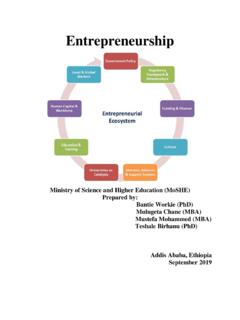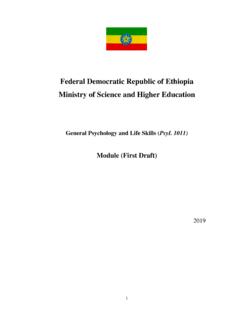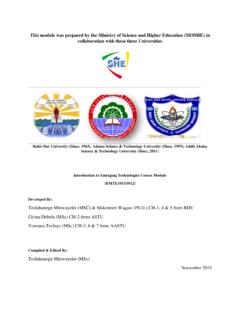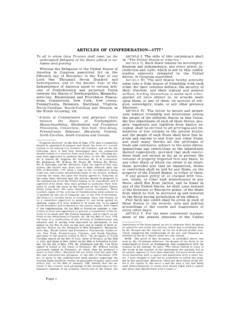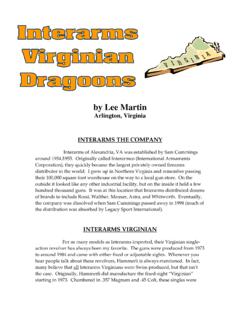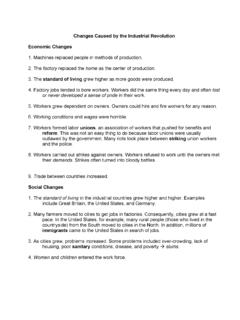Transcription of Ministry of Science and Higher Education (MoSHE
1 Ministry of Science and Higher Education (MoSHE). Common Course Teaching Module Course Title: Global Affairs Course Code: GLAF---- Prepared by: Moges Demissie (PhD). Seife Hailu (Ass. Prof). Addis Ababa, Ethiopia September 2019. Global Affairs Module Contents ..Page Module Introduction .. 5. Course Objectives .. 5. Chapter One: Understanding International Relations .. 6. Introduction .. 6. Objectives .. 6. Conceptualizing Nationalism, Nations and States .. 6. Understanding International 9. The Nature and Evolution of International Relations .. 13. Actors in International Relations .. 18. State Actors .. 18. Non-State Actors .. 19. Levels of Analysis in International Relations .. 22. The individual level .. 23. The group level .. 23. The state level .. 24. The system level .. 25. The Structure of International System .. 26. Theories of International Relations .. 29. Idealism/Liberalism .. 29. Realism .. 32. 37. Constructivism .. 38. Critical 39. Summary .. 41. Self-Check Exercise.
2 42. Chapter Two: Understanding Foreign Policy and Diplomacy .. 43. Introduction .. 43. Objectives: .. 43. Defining National Interest .. 44. Global Affairs Module Understanding Foreign Policy and Foreign Policy Behaviors .. 49. 2. Defining Foreign 50. Foreign Policy Objectives .. 51. Foreign Policy Behavior: Patterns and Trends .. 53. Foreign Policy Dimensions .. 55. Instruments of Foreign Policy .. 58. Overview of Foreign Policy of Ethiopia .. 65. Foreign Policy during Tewodros II (1855-1868) .. 65. Foreign Policy during Yohannes IV (1872-1889) .. 66. Foreign Policy during Menelik II (1889-93) .. 66. Foreign Policy during Emperor Haile Selassie I (1916-1974) .. 68. Foreign Policy during the Military Government (1974 1991) .. 71. The Foreign Policy of Ethiopia in the Post 1991 .. 74. Summary .. 76. Self Check Exercise .. 77. Chapter Three: International Political Economy (IPE) .. 77. Introduction .. 77. Meaning and Nature of International Political Economy (IPE) .. 79. Theoretical perspectives of International Political Economy.
3 82. Survey of the Most Influential National Political Economy systems in the world .. 87. The American System of Market-Oriented Capitalism .. 87. The Japanese System of Developmental 90. The German System of Social Market Capitalism .. 92. Differences among National Political Economy Systems .. 94. Core Issues, Governing institutions and Governance of International Political Economy .. 96. International Trade and the WTO .. 96. International Investment and the WB .. 98. International Finance and the 100. Exchange Rates and the Exchange-Rate 101. Summary .. 102. Self-Check Exercise .. 102. Global Affairs Module Chapter Four: Globalization and Regionalism .. 104. Introduction .. 104. Objectives .. 104. Defining Globalization .. 105. The Globalization Debates .. 106. The Hyper-globalists .. 106. The Skeptics .. 107. The Transformationalist .. 108. Globalization and Its Impacts on Africa .. 109. Ethiopia in a Globalized 114. Pros and Cons of Globalization .. 115. Defining Regionalism and Regional 116.
4 The Old Regionalism .. 118. New 120. Major Theories of Regional Integrations .. 123. Functionalism .. 123. 124. Selected Cases of Regional 126. Regionalization versus Globalization and State .. 127. The Relations between Regionalization and Globalization .. 127. Regionalization as a Component of Globalization: Convergence .. 128. Regionalization as a Challenge or Response to Globalization: Divergence .. 128. Regionalization and Globalization as Parallel Processes: Overlap .. 129. Regionalization, Globalization and the State .. 129. Summary .. 131. Self-Check Exercise .. 132. Chapter Five: Major Contemporary Global Issues .. 133. Introduction .. 133. Objectives .. 133. Survey of Major Contemporary Global Issues .. 134. Global Security Issues .. 135. Global Affairs Module Global Environmental Issues .. 140. Global Socio-economic Issues .. 142. Global Cultural Issues .. 146. Summary .. 147. Self-Check Questions .. 147. References .. 148. Global Affairs Module Module Introduction This module is basically designed for the course, Global Affairs.
5 The course is designed to equip students with the basics of international relations so that they will be exposed to global challenges and perspectives. The course is very comprehensive, broad and multidisciplinary in its nature. Perhaps you may find it as an ice-breaking course since it touches up on wide range of issues, concepts, theories, approaches and debates that are helpful in understanding the contemporary international relations. Concepts, such as national interest, foreign policy, actors, globalization, balance of power, cold war, multi-polar systems, international law and other relevant concepts are being introduced. Different debates and approaches to the study of international relations including realism, liberalism are also given due emphasis. Due to the vastness of the course, its contents are organized into six chapters. The first chapter lays the foundation of the course by introducing major concepts, such as: the nature, scope, evolution, actors and levels of analysis, structure as well as theories of international relations.
6 In the second chapter topics such as; national interest, foreign policy, diplomacy and Ethiopian foreign policy under successive regimes are discussed in some length. Chapter three brings out the contending issues of international political economy with emphasis on global institutions of governance. Last chapter the debates between regionalism and globalization with contemporary global issues that affect international relations. Course Objectives After completing this course, students will be able to: Understand nations, nationalism and states Explain the nature and historical development of international relations Examine the extent and degree of influence of state and non-state actors in the international system Gain basic knowledge of the major theories of International Relations and develop the ability to critically evaluate and apply such theories Elucidate national interest, foreign policy and diplomacy Assess the overriding foreign policy guidelines of Ethiopia in the past and present Explicate the nature and elements of international political economy Examine the roles major international and regional institutions play in world politics Explore Ethiopia s role in regional, continental and global institutions and affairs Critically evaluate the major contemporary global issues Global Affairs Module Chapter One.
7 Understanding International Relations Introduction International relations, as it is presented in the flow of daily news concern a large number of disparate events; leaders are meeting, negotiations are concluded, wars are started, acts of terror committed, and so on. In order to make sense of all this information we need to know a lot about the contemporary world and its history; we need to understand how all the disparate events hang together. At university, we study these topics, but it is a basic tenet of the academic study of international politics that this rather messy picture can be radically simplified. Instead of focusing on the flow of daily news, we focus on the basic principles underlying it. This is what we will try to do in this module. So, let us begin by thinking big; what is international relations?, how was it made?, and how did it come to be that way? Objectives After completing this chapter, you will be able to: Define the meanings and nature of nation, states and nationalism Describe the meaning and evolution of International Relations Acquaint yourself with different perspectives, approaches and paradigm of international relations Identify and analyze the roles different actors play using the three levels of analysis Examine the structure of international system and the laws governing its operation Brainstorming Question: Why does it matter to understand nationalism, nation and states?
8 Conceptualizing Nationalism, Nations and States Nationalism is the most influential force in international affairs. It has caused the outbreak of revolutions and wars across the globe. It is noted as a factor for the collapse of age old empires, marker for new borders, a powerful component for the emergence of new states and it is used to reshape and reinforce regimes in history. Nationalism s triumph is the coming of the nation-state as key actors in world politics-accepted as ultimate, legitimate and the most basic form of political entity. According to Heywood (2014), nationalism is the doctrine that asserts the nation as the basic political unit in organizing society. Global Affairs Module In common parlance, the words nation , state and country are used interchangeably and this is not correct. For instance, the word the United Nations is a misnomer since in reality it is an association or a society of states-instead of nations. In international politics, it is also common but incorrect to refer the Chinese , the Americans and the Russians as nations.
9 Hence, the question remains: what is a nation? According to Heywood, nations are historical entities that evolve organically out of more similar ethnic communities and they reveal themselves in myths, legends, and songs (2014). On the other hand, at the end of the eighteenth century this state came to be radically transformed. The state was combined with a nation forming a compound noun the nation- state which was organized differently and pursued different goals. A nation, in contrast to a state, constitutes a community of people joined by a shared identity and by common social practices. Communities of various kinds have always existed but they now became, for the first time, a political concern. As a new breed of nationalist leaders came to argue, the nation should take over the state and make use of its institutional structures to further the nation s ends. In one country after another the nationalists were successful in these aims. The nation added an interior life to the state, we might perhaps say; the nation was a soul added to the body of the early modern state machinery.
10 The revolutions that took place in Britain s North American colonies in 1776 , and in France in 1789, provided models for other nationalists to follow. We the People of the United States the first words of the Preamble to the US Constitution was a phrase which itself would have been literally unthinkable in an earlier era. In France, the king was officially the only legitimate political actor and the people as a whole were excluded from politics. In addition, the power of the aristocracy and the church remained strong, above all in the countryside where they were the largest landowners. In the revolution of 1789, the old regime was overthrown and with it the entire social order. The French nation was from now on to be governed by the people, the nation, and in accordance with the principles of libert , galit et fraternit liberty, equality and brotherhood. Activity Discuss in groups the similarities and differences of nationalism, nation, nation-state Examine the place of war in the evolution of the European state system Global Affairs Module The Congress of Vienna of 1815, where a settlement was reached at the end of the Napoleonic Wars, was supposed to have returned Europe to its pre-revolutionary ways.
